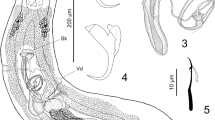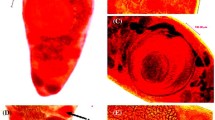Abstract
The Splanchnotrophidae are a worldwide-distributed family of endoparasitic copepods, utilising shell-less opisthobranch gastropod hosts. Using scanning electron microscopy, we describe three new Ismaila Bergh, 1867 species infesting nudibranch hosts from southern Chile. Ismaila volatilis spec. nov. infests the proctonotid Janolus sp. and differs from all congeners by the size and number of dorsal bulges, the number of processes on the maxilla, and the thickness of thoracic appendages. Ismaila chaihuiensis spec. nov. was found in the doridoidean Diaulula punctuolata (D’Orbigny, 1837) and is diagnosed by a pore situated on a prominent bulge above the labrum. Ismaila genalis spec. nov. from a polycerid Holoplocamus papposus Odhner, 1926 host differs from its congeners in the size and form of the ventral bulges present on the head. These discoveries further broaden the range of splanchnotrophid host taxa; they are in line with earlier hypotheses of strict host specificity of Ismaila species and support Chile as a hotspot for Ismaila radiation. Herein, we present a key to the identification of all 14 Ismaila species. In Sulawesi (tropical Indo-West Pacific), Arthurius gibbosa spec. nov. infests the sacoglossan Elysia macnaei Marcus, 1982. The new species differs from both congeners by the short and stubby dorsal bulges. Uniquely among splanchnotrophids, long thoracic appendages are absent. Arthurius Huys, 2001 thus is the morphologically most divergent genus of the Splanchnotrophidae, but it is well characterized by the loss of several mouthparts and the preference for sacoglossan hosts. Currently, the distribution of the genus is limited to the Indo-West Pacific.







Similar content being viewed by others
References
Abad M, Díaz-Agras G, Urgorri V (2011) Anatomical Description and Biology of the Splanchnotrophid Splanchnotrophus gracilis Hancock & Norman, 1863 found parasitizing the Doridacean Nudibranch Trapania tartanella Ihering, 1886 at the Ría de Ferrol (Galicia, NW Iberian Peninsula). Thalassas 27:49–60
Anton RF, Schrödl M (2013a) The gastropod—crustacean connection: towards the phylogeny and evolution of the parasitic copepod family Splanchnotrophidae. Zool J Linn Soc 167:501–530
Anton RF, Schrödl M (2013b) The “inner values” of an endoparasitic copepod—computer-based 3D-reconstruction of Ismaila aliena. Spixiana 36:183–199
Belcik FP (1965) The morphology of Ismaila monstrosa Bergh (Copepoda). Master of Science, Oregon State University
Belcik FP (1981) The male of Ismaila monstrosa Bergh, 1867 (Copepoda, Splanchnotrophidae). Crustaceana 40:16–25
Bergh R (1867) Phidiana lynceus og Ismaila monstrosa. Vidensk Medd Nat hist Foren 97–130, pls. 133–134
Boxshall GA, Strong EE (2006) An extraordinary shift in life habit within a genus of cyclopoid copepods in Lake Tanganyika. Zool J Linn Soc 146:275–285
Coleman N (2001) 1001 Nudibranchs: catalogue of Indo/Pacific sea slugs. Identification—biodiversity—zoology: the ultimate photo-guide. Neville Coleman’s Underwater Geographic (July 2001), Springwood, Qld
Gotto RV (1979) The association of copepods with marine invertebrates. Adv Mar Biol 16:1–109
Gruner HE, Moritz M, Dunger W (1993) Lehrbuch der Speziellen Zoologie, Band I: Wirbellose Tiere, 4.Teil: Arthropoda (ohne Insekten). Gustav Fischer Verlag
Haumayr U, Schrödl M (2003) Revision of the endoparasitic copepod genus Ismaila Bergh, 1867, with description of eight new species. Spixiana 26:1–33
Ho JS (1981) Ismaila occulta, a new species of poecilostomatoid copepod parasitic in a dendrodorid nudibranch from California. J Crust Biol 1:130–136
Ho JS (1991) Phylogeny of Poecilostomatoida: a major order of symbiotic copepods. Bull Plankton Soc Japan Spec Vol 25–49
Huys R (2001) Splanchnotrophid systematics, a case of polyphyly and taxonomic myopia. J Crust Biol 21:106–156
Huys R, Boxshall GA (1991) Copepod evolution. The Ray Society, London, England 159:468 pp
Østergaard P, Boxshall GA, Quicke DLJ (2003) Phylogeny within the Chondracanthidae (Poecilostomatoida, Copepoda). Zool Scr 32:299–319
Salmen A, Kaligis F, Mamangkey GF, Schrödl M (2008a) Arthurius bunakenensis, a new tropical Indo- Pacific species of endoparasitic copepods from a sacoglossan opisthobranch host. Spixiana 31:199–205
Salmen A, Wilson NG, Schrödl M (2008b) Scanning electron microscopical description and biology of three new endoparasitic Ceratosomicola species from tropical Indo- Pacific nudibranch hosts. Spixiana 31:47–69
Salmen A, Anton R, Wilson NG, Schrödl M (2010) Briarella doliaris n. sp., a new philoblennid copepod parasite from Australia: a potential link to the Splanchnotrophidae (Crustacea, Copepoda, Poecilostomatoida). Spixiana 33:19–26
Schrödl M (2002) Heavy infestation by endoparasitic copepod crustaceans (Poecilostomatoida: Splanchnotrophidae) in Chilean opisthobranch gastropods, with aspects of splanchnotrophid evolution. Org Divers Evol 2:19–26, Plus Electronic Supplement (Parts 11 and 12) at http://www.senckenberg.de/odes/02-03.htm
Schrödl M (2003) Sea slugs of southern South America. Hackenheim (ConchBooks)
Schrödl M (2009) Opisthobranchia - Sea Slugs. In: Häussermann V, Fösterra G (eds) Marine benthic fauna of Chilean Patagonia. Nature in Focus, Santiago, p 1000
Schrödl M, Hooker Y (2014) Sea slugs (Mollusca: Heterobranchia) of Peru: Peruvian-Chilean faunal elements. Spixiana 37:45–59
Uyeno D, Nagasawa K (2012) Four new species of splanchnotrophid copepods (Poecilostomatoida) parasitic on doridacean nudibranchs (Gastropoda, Opisthobranchia) from Japan, with proposition of one new genus. Zoo Keys 247:1–29
Acknowledgments
We would like to thank the entire team of the Laboratorio Costero de Recursos Acuáticos Calfuco near Valdivia and the staff of the Huinay Scientific Station for the great convenience and hospitality during the collection trip to southern Chile. We also thank one anonymous referee for the helpful comments on the manuscript. Roland Anton was funded by the University of Bavaria e.V. The fieldwork in Indonesia was supported by the GeoBioCenter of the Ludwig-Maximilians- University (LMU) Munich and the German research Foundation (DFG SCHR 667/3). Collecting trips to Chile were supported by the German Research Foundation (DFG SCHR 667/2,4 to Michael Schrödl), the GeoBioCenter of the LMU Munich and the University of Bavaria e.V.
Declaration of Ethical Standards
The authors hereby declare that all expereiments were complient with the current laws.
Conflict of interest
The authors hereby declare that there is no conflict of interest.
Author information
Authors and Affiliations
Corresponding author
Additional information
Communicated by P. Martinez Arbizu
Rights and permissions
About this article
Cite this article
Anton, R.F., Schories, D., Jörger, K.M. et al. Description of four new endoparasitic species of the family Splanchnotrophidae (Copepoda, Poecilostomatoida) from nudibranch and sacoglossan gastropod hosts. Mar Biodiv 46, 183–195 (2016). https://doi.org/10.1007/s12526-015-0350-8
Received:
Revised:
Accepted:
Published:
Issue Date:
DOI: https://doi.org/10.1007/s12526-015-0350-8




